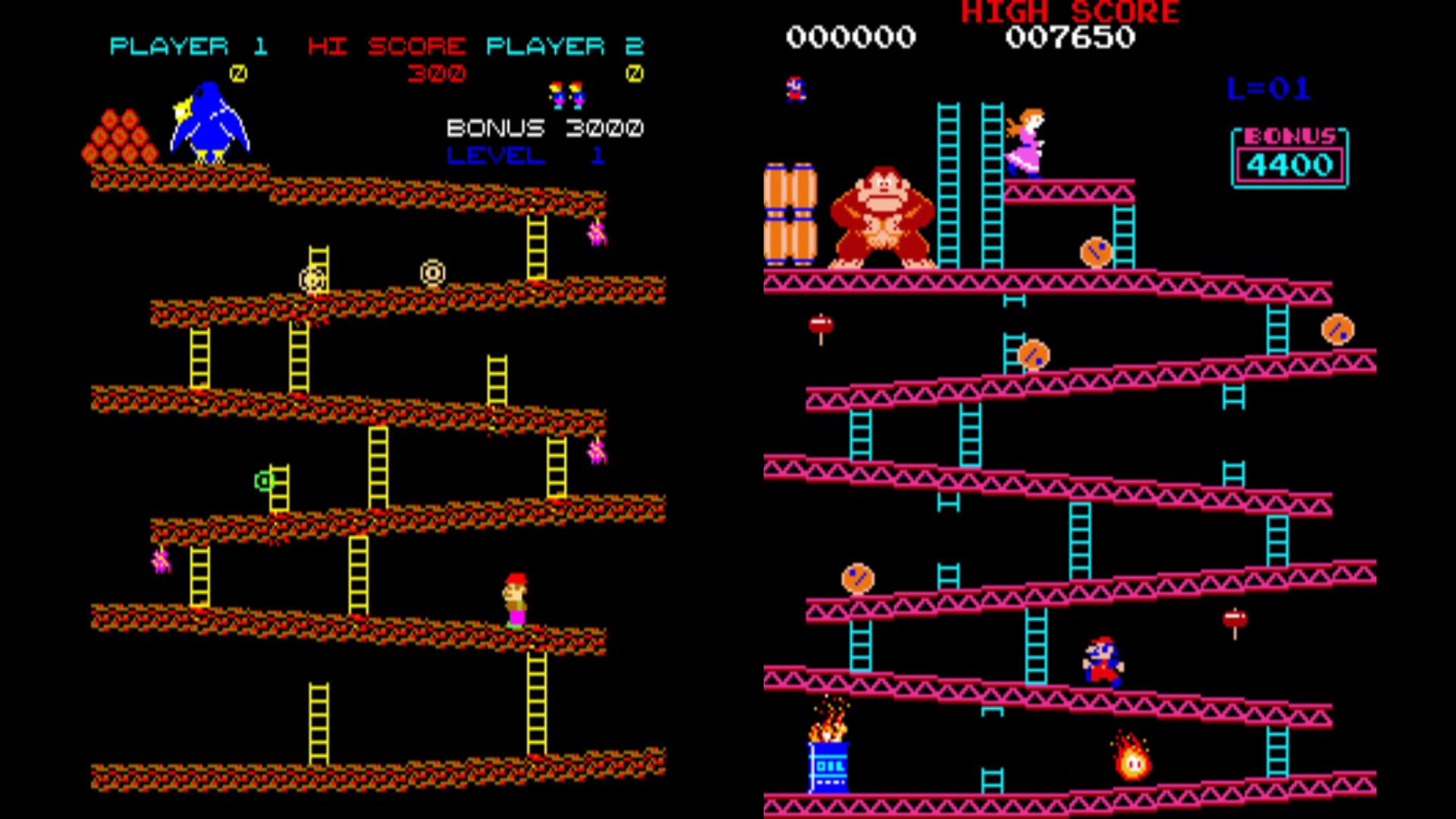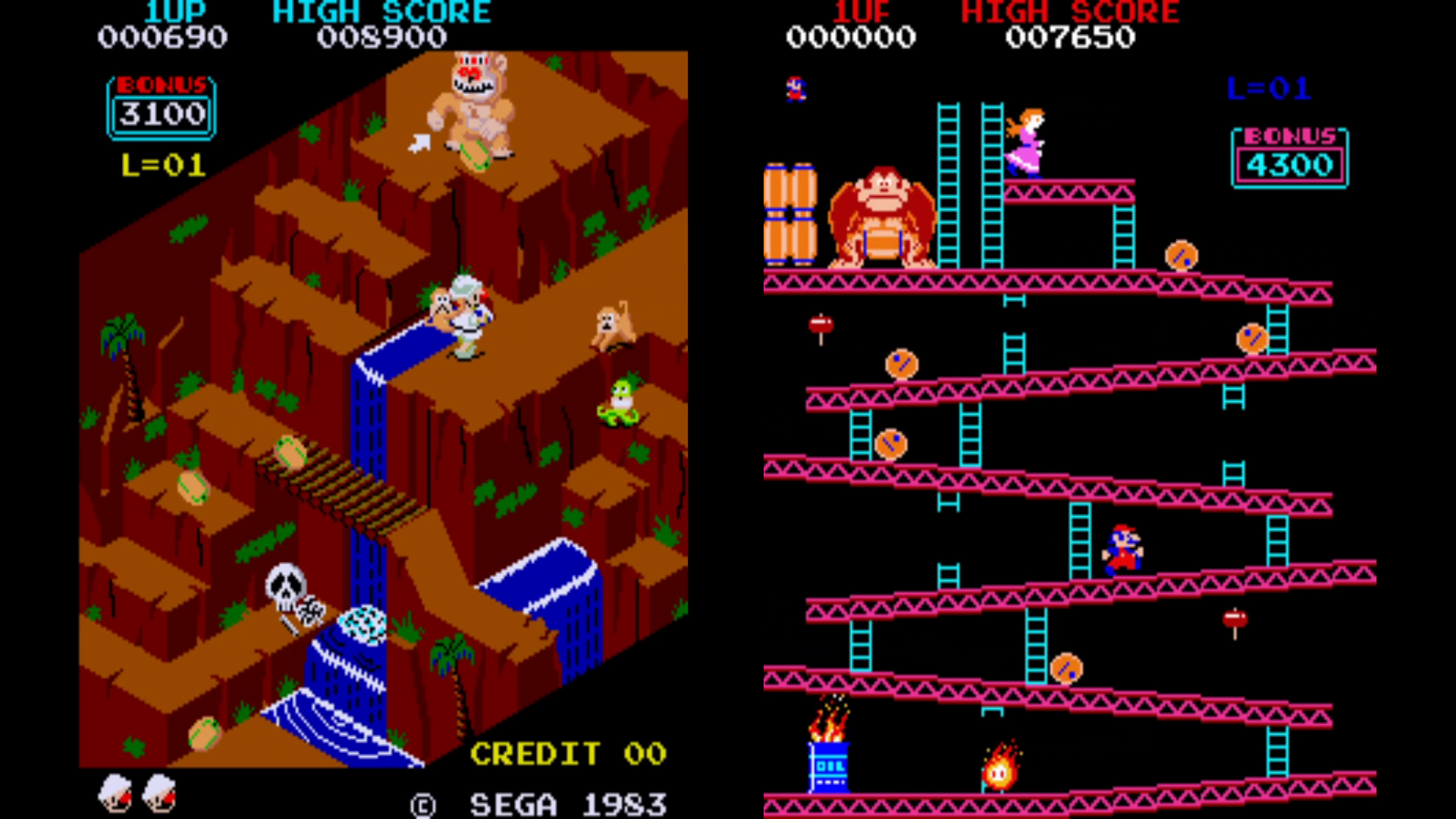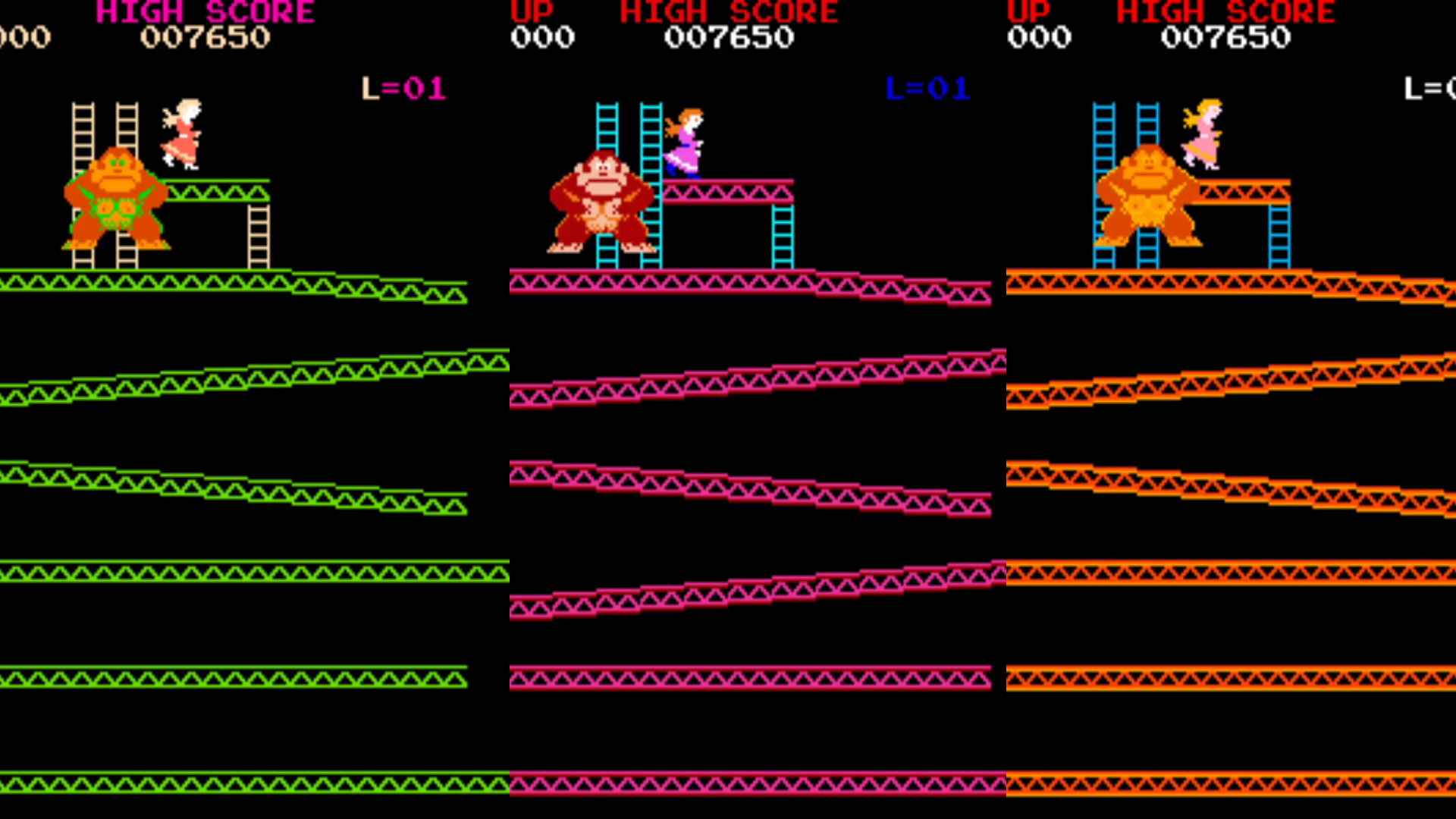These Donkey Kong arcade clones show just how much these bootleg developers will copy from the classic, original Donkey Kong arcade game. They copy it in order to trick consumers into playing their knockoff game because they are familiar with the art/game mechanics already.
Again, just like my past clone articles, I only want to include arcade cabinet released clones of Donkey Kong. There are a ton of other Donkey Kong clones released on classic home consoles. I will focus on the arcade released copycats.

List of Donkey Kong Arcade Clones
- Logger (Arcade, 1982)
- Congo Bongo (Arcade, 1983)
- Crazy Kong (Arcade, 1981)
- Crazy Kong Part II (Arcade, 1981)
Logger Arcade Game
Logger was released by Century Electrics 1 year after the original Donkey Kong, in 1982.
The gameplay is identical to Donkey Kong. The level layouts are the same.
They changed the art, though. This is most likely to try to avoid any copyright issues even though everything else is virtually the same.

- A bird replaces Donkey Kong on top of the screen.
- The bird throws logs instead of barrels.
- The player’s sprite is changed too, but they didn’t bother to change it too much as the man in Logger kept the same mustache that Mario has.
Objectives to win have been changed. In Logger, you must remove all the wood to beat the level.
Congo Bongo Arcade Game
Congo Bongo was made by Sega and released to arcades in 1983.
The game looks a little different from the original Donkey Kong. It is an isometric view with a lot more vibrant and colorful characters and levels.
The gameplay of Congo Bongo is where you can see they drew quite a bit of inspiration from Donkey Kong. An ape, named Bongo, throws things down on the player from the top of the screen.
The main character has a big red nose and is in explorers gear. He does have a mustache just like Mario.
This explorer man needs to avoid all the obstacles and work his way through the maze-like path to reach the top of the screen in order to beat the level.

There are four levels in Congo Bongo.
The first level is called Primate Peak. Bongo throws rolling coconuts down at the player, similar to the barrels in Donkey Kong. Snakes will move at the player to slow them down and throw them off the cliff.
The second level is Snake Lake. It adds scorpions for the character to avoid. Hippos dive in and out of the water so you need to time your jumps to get across them.
The third level is Rhino Ridge. Rhino herds charge you. You will need to go into mole holes to avoid them but if you stay too long then moles will fill them in.
The last level is Lazy Lagoon. Cross the water by jumping on hippos again, along with lily pads. Once you reach land, the rhinos return to charge you down. Reach Bongo at the top to see the final cutscene. From here you start over from level one but with increased difficulty.
This game received pretty poor reviews. Critics said the gameplay was repetitive and frustrating. They also said the music was annoying after playing for a while.
Crazy Kong and Crazy Kong Part II Arcade Games
Crazy Kong and Crazy Kong Part II have strange stories of how and why they came to exist. There are also odd, almost negligible differences between each other and the original Donkey Kong.
The Crazy Kong arcade games are clones of Donkey Kong but they did not exactly steal from Nintendo. That is because Nintendo officially licensed the game but only for operation in Japan.
Nintendo did this because they were so busy in America that they did not have time to make and distribute an arcade game overseas.
They even outsourced the development of the Crazy Kong arcade cabinets and games to a different company. That company was Falcon. Falcon made the games with all new hardware so they had to redraw and recolor the graphics. Falcon made sure to keep the exact same gameplay elements of Donkey Kong.

Falcon made a sequel called Crazy Kong Part II. Though, this game is just a copy of the first with only minor graphical changes.
Both Crazy Kong I and Crazy Kong II run on the modified arcade cabinet of another classic game, Crazy Climber.
When Falcon remade these games to presumably copy every aspect of Donkey Kong, they didn’t get it perfect. There are slight changes among all the games.
List of Differences Between Crazy Kong and the Original Donkey Kong
The title screen in the Crazy Kong games does not have the copyright or company name that is usually there in the original Donkey Kong.
Crazy Kong contains green metal girders, compared to the magenta color in Donkey Kong.
Mario has brown and dark red colors. In the original he is blue and bright red.
The front facing sprite of the gorilla is different. You can tell that Crazy Kong’s gorilla is taller and more vicious looking when he opens his mouth.
Crazy Kong has some rolling barrel animations missing.
All the sounds are taken from the Crazy Climber arcade game. The background humming music is not present. The sound effects overall sound more crude. Mario says “hi-yah” when he jumps. The gorilla beating his chest sound comes directly from the gorilla in the Crazy Climber game.
There is a cheat to beat the first level that is not found in the original Donkey Kong.
Some sprites are removed entirely and other sprites are positioned a little differently from the original sprites.
Some say that Crazy Kong is a more difficult game than Donkey Kong because the collisions are less forgiving.
For a visual comparison among all the Donkey Kong clones see the video below.
Comparison: Crazy Kong vs. Crazy Kong Part 2
The metal girders are orange/red in Crazy Kong Part II.
Mario is colored like the original Donkey Kong, unlike the first Crazy Kong.
After completing 100m the text “Give up” appears, which doesn’t happen in any of the other games.
Part II adds a cinematic scene at the beginning showing Crazy Kong break out of a cage.
Other than those slight changes, these games play and look almost identical.
Legal Trouble: Nintendo vs. Crazy Kong (Falcon)
In January 1982, Nintendo revoked Falcon’s license for Donkey Kong. They did this because Falcon was exporting Crazy Kong cabinets outside of Japan which breached their contract.
That is not the end of Falcon’s bootlegging career. The company made an arcade game called Crazy Kong Jr.
Yup…they cloned Donkey Kong Jr. and this time they weren’t licensed by Nintendo or didn’t have their permission.
Donkey Kong Clones Conclusion
A lot of these companies did not get in legal trouble because of the clones they made. Yeah, some are distinct enough from the originals, but others just copied the classic arcade games directly without authorization to do so.
I have enjoyed researching these 1980s classic arcade game clones. They are interesting to learn about and to dissect all the small variations from the originals. Hopefully you like this arcade clone information too.